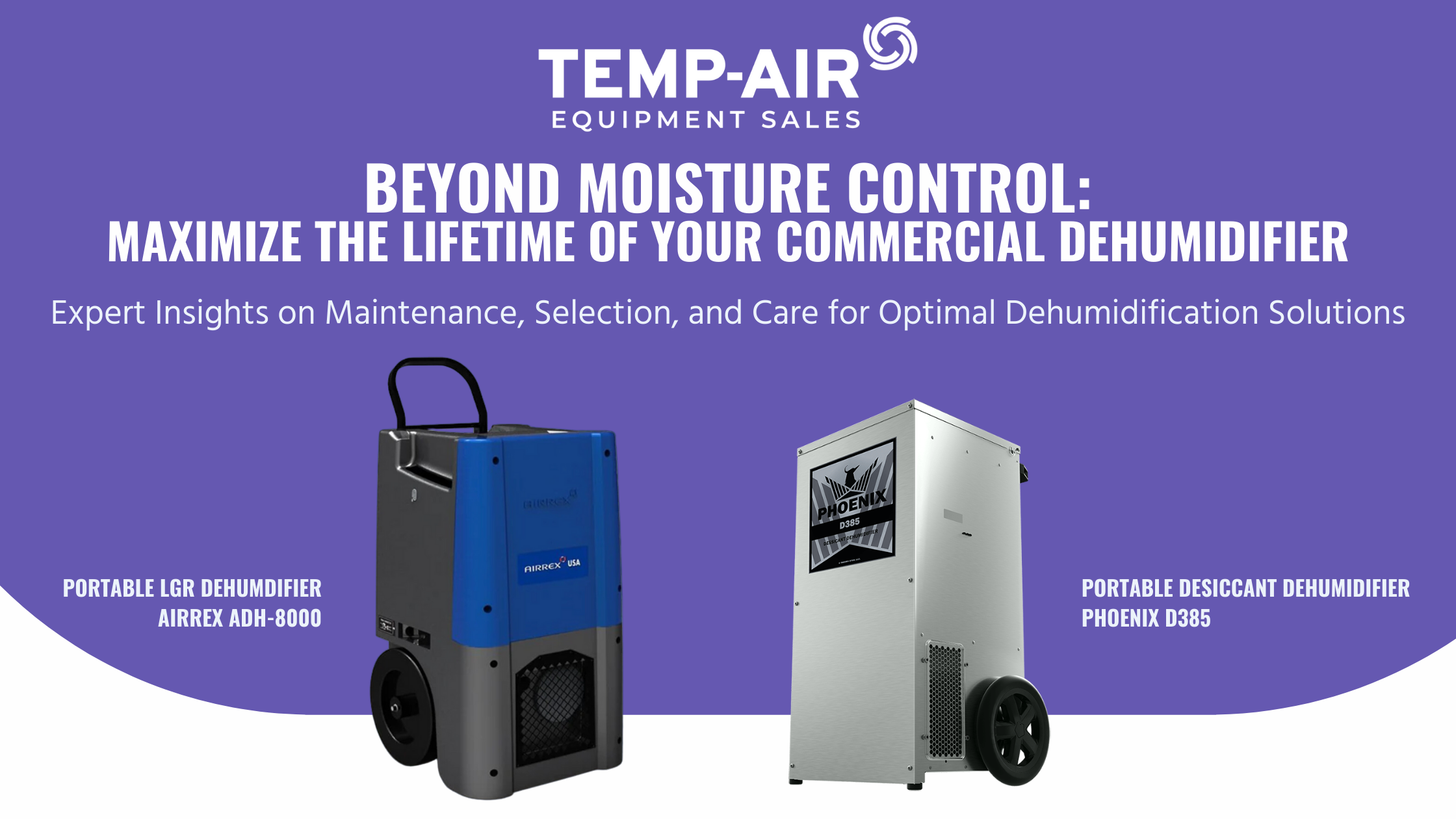
Beyond Moisture Control: Maximize the Lifetime of Your Commercial Dehumidifier
Expert insights on maintenance, selection, and care for optimal dehumidification solutions
Commercial dehumidifiers are portable HVAC units equipped with a high capacity to remove moisture from the air in warehouses, manufacturing facilities, industrial processes, construction sites, and more. Yet, with constant use, even the most reliable dehumidifier has its limits. The good news is with proper care, a great unit can last for years to come. Understand the differences between the types of dehumidifiers, recognize the factors that impact a unit’s lifespan, and learn the best maintenance practices to maximize years of service out of a portable dehumidifier.
Low-grain refrigerant or desiccant dehumidifier: What’s the difference?
Understanding the technology behind the different types of commercial dehumidifiers will help you understand the unit’s uses and maintenance. There are two different types of systems used in dehumidifiers: desiccant and low-grain refrigerant (LGR). While both are ideal for humidity control and moisture removal, knowing the specifics about the two types of dehumidifiers ensures the units are best cared for and best used.
The Power of LGR Dehumidifiers
The internal system of an LGR dehumidifier uses refrigerant coils to cool the air and condense moisture out, requiring occasional or regular draining, depending on the frequency of use. LGR dehumidifiers remove moisture from air with low humidity, making them perfect for large-scale projects, water damage restoration needs, and controlled environments where temperatures are consistently above the refrigerant’s freezing point. These units are built for durability and ease of transport, with sturdy wheels, handles, and a compact size for easy maneuverability in tight spaces – a plus for restoration professionals.
Check out the Airrex ADH-8000 to learn more about LGR dehumidifiers.
The Efficiency of Desiccant Dehumidifiers
Desiccant dehumidifiers draw moist air over a silica gel-coated desiccant wheel, absorbing moisture and releasing drier air back into the environment. These units are functional in a broad temperature range, from very cold spaces to moderate environments. This ability makes them vital for applications requiring absolute humidity control or operating in frigid temperatures, including food processing plants, the pharmaceutical industry, and more. When continuously used, desiccant dehumidifiers achieve significantly lower relative humidity levels than refrigerant dehumidifiers, operate at a quieter volume, and do not require any condensation dumping.
Check out the Phoenix D385 to learn more about desiccant dehumidifiers.
Whether it’s ensuring the integrity of your products, maintaining the health of your workers, or safeguarding critical processes, the right dehumidifier can make all the difference.
How Long Does a Commercial Dehumidifier Last?
With typical use, a commercial dehumidifier can run for up to 5 to 10 years before needing a replacement. With proper preventative maintenance and a daily operation time of less than 12 hours in a relatively clean-air environment, most commercial dehumidifiers last for years. Its actual lifespan depends on several factors:
- Usage hours: Increased hours of operation per day/week will accelerate wear; 10–12 hours of daily use may only yield four years of service.
- Environmental conditions: Continuous operation in humid climates, including exposure to chemicals, dust, and other airborne particles, can lead to wear and tear of internal components.
- Water quality: Hard water leaves mineral deposits on the coils and in collection tanks, which could disrupt air and moisture flow. This could lead to reduced efficiency and long-term damage to internal components. Frequent flushing is required in hard water areas.
Routine Maintenance to Keep Your Unit Operating for Years:
Regular maintenance routines are the key to utilizing every possible year of service from a commercial dehumidifier. Because maintenance routines allow you to catch minor issues before they become expensive repairs, expert technicians from TEMP-AIR® Equipment Sales recommend the following routines:
- Change filters monthly to prevent restricted airflow. Clogged filters strain internal components.
- Inspect and clean coils annually with a mild cleaner. Mineral deposits reduce heat transfer and efficiency.
- Lubricate all moving parts per manual guidelines to prevent premature wear.
- Monitor the unit, track its daily run hours, and service it promptly once it hits the 5-year mark.
How TEMP-AIR® Equipment Sales Can Help
Whether it’s time to replace an aged commercial dehumidifier or to purchase one to have on hand for any emergency, rely on the experts at TEMP-AIR® Equipment Sales. As the premier provider in portable climate solutions, we offer a wide selection of commercial-grade desiccant and LGR dehumidifiers to suit any application. Our team can assess your issue, recommend the right unit, and assist with all service and maintenance needs. With our extensive inventory of onsite replacement parts and team of experts, we are always available to get your equipment back up and running fast. Whether it’s through shipping replacement parts within 24 hours, guiding you through maintenance needs, or servicing your unit at our warehouse, TEMP-AIR® Equipment Sales is here for you.
Contact us today to learn more about portable commercial dehumidifiers. Explore our product catalog or speak to a team member about maximizing humidity control in your facility.
